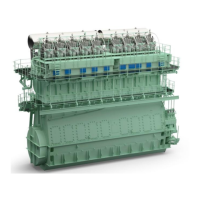
Do you have a question about the WinGD W-X82 and is the answer not in the manual?
| Bore | 820 mm |
|---|---|
| Cylinder Configuration | Inline |
| Specific Fuel Oil Consumption | 165 g/kWh |
| Engine Type | Two-stroke diesel |
| Fuel Type | Heavy Fuel Oil (HFO), Diesel, LNG |
| Application | Container ships, tankers, bulk carriers |
| Tier | IMO Tier II and Tier III compliant |
Covers preface, subject index, abbreviations, and how to use the manual.
Steps for starting after short shutdown, fuel system, servo oil, and cylinder lubrication prep.
Details on general data, safety, slow turning, engine start, and usual operation.
Procedures for decreasing load, stopping the engine, and post-stop actions.
Covers running-in, indicator diagrams, contamination prevention, and crankcase explosions.
Details on the main bearing's general structure, lubrication, and installation.
Covers the general installation and function of the thrust bearing.
Explains the general function and configuration of tie rods.
Details on cylinder liner general structure, cooling, and lubrication systems.
Explains the location and function of lubricating quills on the cylinder liner.
Describes the general function and structure of the piston rod gland.
Covers the general function and components of FAST injection valves.
Explains the general function and start sequence of the starting air valve.
Details on exhaust valve general structure, function, hydraulic system, and air supply.
Explains the engine's built-in axial damper, its function, and monitoring system.
Covers the general structure and lubrication of connecting rods and bearings.
Details the parts of the piston and the piston cooling system.
Describes the WECS-9520 system, its components, and engine/cylinder functions.
Explains how to access and adjust user parameters and maintenance settings.
Outlines essential checks and recommendations for the WECS-9520 system.
Provides an overview of engine control, diagrams, functions, and system checks.
Details the general structure, function, and lubrication of the fuel pump.
Provides procedures for cutting out and cutting in fuel pumps.
Explains the general operation, emergency stop, and emergency operation of the valve.
Describes the general structure and components of the fuel pump unit.
Details the general function and operation of the fuel pump actuator.
Covers the general structure, function, and lubrication of the servo pump unit.
Details the general structure, function, and lubrication of the servo pump unit.
Explains the general structure and function of the scavenge air receiver.
Covers the general function and operation of the turbocharger.
Provides general information and procedures for cleaning the turbocharger.
Details the auxiliary blower and its associated switch box function.
Covers general operation, instructions, and cleaning procedures for the SAC.
Explains the function and operation of the exhaust waste gate for low-load tuning.
Discusses the types of oil, running-in, and general recommendations for cylinder lubrication.
Explains the location and function of lubricating quills on the cylinder liner.
Details the lubrication process for the exhaust valve spindle.
Describes the control system for cylinder lubrication using ALM-20 and WECS-9520.
Provides guidance on adjusting the cylinder lubricating oil feed rate based on analysis.
Details the lubricating oil system for 6- to 8-cylinder engines.
Details the lubricating oil system for 9-cylinder engines.
Covers the general aspects and function of the cooling water system.
Provides a schematic of the starting air and control air systems.
Details the fuel system for 6- to 8-cylinder engines, including low and high pressure circuits.
Details the fuel system for 9-cylinder engines, including low and high pressure circuits.
Explains the function and operation of the exhaust waste gate for low-load tuning.
Covers the general structure and schematic of the engine instrument panel.
Explains the general function and components of the crank angle sensor unit.
Provides schematic diagrams of pressure switches and transmitters.
Details the general function, safety, installation, operation, and cards of the ICC system.
Explains the general structure, function, and LED indications of the oil mist detector.
Details the general structure, function, and schematic diagram of the oil mist detector.
Describes the general location of electronic components and control boxes.
